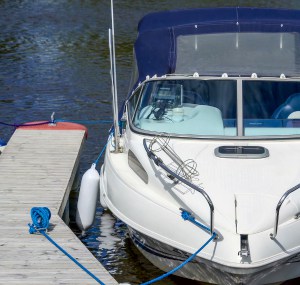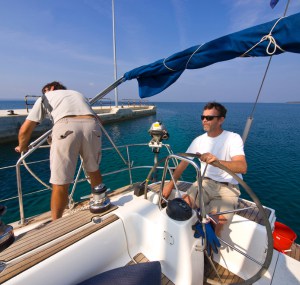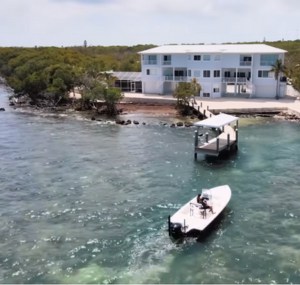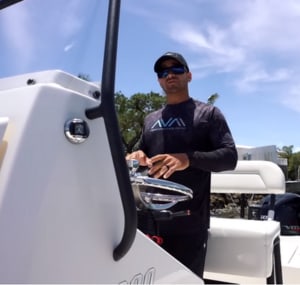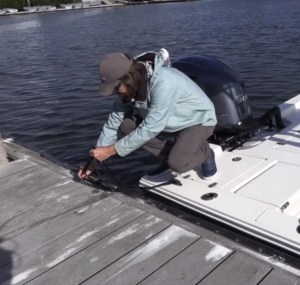How to dock a boat in a tight slip effectively and safely is a competence all boat owners must master. Although docking boats should be as easy as parking a car in a parking lot, the maneuver requires careful boat docking techniques.
Unlike parking on land, docking a vessel requires maneuvering the watercraft so it “backs” into the slip. The image below describes how sailors park a boat.
Do not fret because we will present how you can dock the boat in slip confidently and safely. Please keep reading.
Table of Contents
Steps to Dock a Boat in a Tight Slip-add Tutorial Video
What to Prepare
Besides the boat, you only need two things to dock a watercraft in a tight slip safely and confidently.
- Fenders to avoid damaging your boat when it “bumps” into the dock
- A boat line to tie a pontoon boat to a dock (or any watercraft)
Step 1. Prepare your boat.
Preparing to dock your boat requires readying your gear, including the fenders and boat lines. This step is crucial to ensure everything is on hand before you dock a yacht or watercraft into the slip. Moreover, it saves energy and effort if you are parking the boat by yourself.
- Position the boat fenders on the boat’s exterior sides and at a height that will absorb the impact with the dock platform.
- Secure the boat lines to the watercraft’s stern and bow cleats to ready them for tying at the dock.
- Pontoon boats and gated watercraft require opening the gates to facilitate a better visual assessment of your approach.
Step 2. Scan and assess your surroundings.
Throttle down as you approach the marina. Many obstacles and potential hazards are present in a marina. Recall your knowledge of the waters in this area to avoid accidents. For example, where are the sandbars, underwater rocks, fast-running currents, and other potential dangers?
- Consider the wind conditions. Docking with the wind blowing stronger than usual might require more power from your boat.
- Determine your path in cases where you must abort docking and re-attempt landing.
- Check the dock’s water depth. You might want to adjust your boat’s trim if the water is shallow.
Step 3. Approach the dock.
The best way to dock a boat is to stay calm. Most greenhorn boaters become very tense when approaching the dock the first few times. You might want to practice on a simulator to gain confidence in this step.
- Take your boat at the slowest possible speed. Be patient, especially if you are a newbie.
- As you near the boat slip, put your watercraft into neutral before sliding it into reverse. This action will help you stop the sterndrive boat in the water.
Step 4. Maneuver your boat
Natural forces and the watercraft’s power can make maneuvering your boat with twin engines challenging. Ideally, you will want to maintain a few boat lengths of maneuvering room between your watercraft and the dock.
- Keep your hands on your boat’s throttle controls, slightly increasing power and going into neutral to maintain the ideal position. This technique is crucial when docking a watercraft in a space-limited slip.
- Continue scanning your surroundings, ensuring your path is free of other watercraft and obstructions.
- Wait for other boaters to complete their docking procedures before you maneuver your watercraft into position.
Step 5. Enter the boat slip
Here comes the tricky part. This step requires attention to boat movements, surrounding circumstances, and throttle controls. The ideal watercraft controls are short thrust bursts and idle speeds (please see the image again).
- Let your boat glide into position at forward idle.
- Shift the boat’s gear to neutral once you are in position.
- Let the water current, waves, or wake push or swing the boat’s stern section toward the slip, with the bow as a pivot. Please remember, we do not dock in a slip bow first.
- Maintain the bow’s alignment to the dock and apply short bursts of reverse idle to swing the watercraft into position.
- Apply short bursts of forward and reverse idle speeds until the boat is parallel to the dock.
Step 6. Secure the watercraft.
Learning how to tie a boat to the slip is as essential as mastering docking the watercraft into the slip.
- Assess your vessel landing and positioning before you tie a pontoon boat to a dock cleat or post.
- Shift the watercraft into neutral and remove your safety lanyard.
- Ask someone to secure the boat lines (stern and bow) to the dock cleats or other structures. You might have to do this step yourself if nobody else is around.
- Turn off the boat engine and make the necessary adjustments.
Tips to Park Your Boat in a Tight Slip
Parking a boat is more frightening and anxiety-provoking than slotting a car into a parking space. Here are some tips to help you feel more confident docking your watercraft in tight spots.
- Be mindful of your speed and spatial awareness to minimize the risk of collisions. Docking a large boat is trickier than landing a dinghy because size limits the visibility of the ship’s immediate surroundings.
- “Read the wind” and anticipate its direction and impact on your boat’s movements. Strong winds can push your boat unnecessarily, requiring you to compensate for every wind-related action.
- Please remember that docking single-engine boat units vary from twin-engine versions. You must adjust the vessel’s direction before propelling it into position. Meanwhile, a twin-engine watercraft only requires thrust adjustments for maneuvering.
- Applying short thrust bursts is safer and more efficient than going into a slip at full throttle.
- Please do not turn off the boat engine until the vessel is tied securely on the dock and you are content with its position. Shifting to neutral is ideal when making minute adjustments.
Frequently Asked Questions
Why boats back into slips?
This question is a valid concern for many greenhorn boaters. So, why do boats back into slips? The most significant reason boaters do this technique is to ensure the watercraft’s pointed bow section faces oncoming waves or wakes.
Docking on the boat’s side might produce scratches. The bow’s unique design allows it to cut or slice through wakes and waves. On the other hand, exposing the boat’s rear or stern to these water conditions can increase the risk of severe damage.
What’s a slip?
The boat slip meaning conjures images of a parking slot for watercraft. Although most folks know it as “docking,” a slip is a structure for mooring or berthing boats. It does not matter what types of boat slips you have. The function will be identical.
Conclusion
Mastering how to dock a boat in a tight slip can be a nerve-wracking experience for greenhorn sailors. Although our six-step docking procedure is straightforward, we strongly recommend practicing the steps, techniques, and maneuvers to build confidence.
Go easy on the approach and apply only short bursts of power to your boat to get it into the correct position. Always read the water, wind, and surroundings. Please remember to secure your vessel at the dock. Otherwise, you will do the procedure again.

Ten years of enjoying countless trips on boats never made me love them any less! So I am here to put all those experiences into good use for other boaters who want to have a safe and fun trip with their friends and families.



